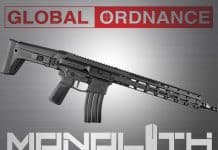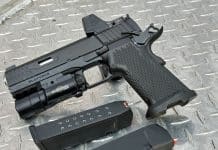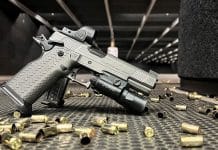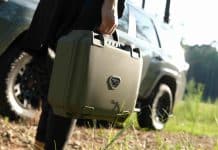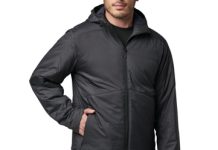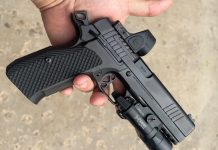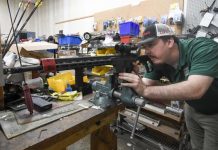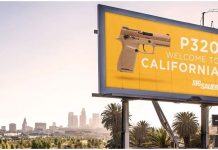One of the best parts of this gig is the learning. Always a student, no matter your knowledge base…there’s always someone out there that knows more than you. In my case, there are scores of people that have forgotten more than I’ll ever know, so I count myself fortunate to be able to have the opportunity to talk with them.
Case in point, the good folks at SI-Defense. I first handled a few different rifle platforms by them a couple of months ago, and I am quite intrigued. One of the the things I alluded to in my previous blog post was that SI-Defense had partnered with PROOF Research for a unique carbon fiber-wrapped barrel that is assembled on their ambidextrous .308.
Once photos started surfacing due to marketing efforts from Reign Precision, I started getting a ton of questions about the PROOF Research barrel, and why was it so special. I do not speak on what I don’t know and I know NOTHING about long distance or precision shooting. I actually have never shot out past 200 yards before, and at that, I wasn’t very good. This deficiency is obviously something that I want to rectify, however for now; it is just a known weakness.
So instead of faking it or ignoring the questions asked of me, I was able to get in contact with the real experts from PROOF Research themselves. They could speak to their barrels and fabrication process much better than I ever could, so I would like to pass along my exchange with Chad VanBrunt, PROOF Research’s Development Engineer.
CT: How do your barrels augment/compliment the SI-Defense .308 platform?
CVB: We started our collaboration effort with SI Defense by understanding what their goals are for the platform itself and then designing the barrel to help them meet their goals. The 18” barrel we designed for the AMBI 308 came in lighter than the 16” steel barrels they were using, provided an additional 60-70fps of velocity, and had better group to group consistency (group size and group center of impact).
CT: Why carbon fiber wrap? Can you explain the wrapping process, what are the advantages/disadvantages of the carbon fiber?
CVB: Composite wrapping barrels in the way PROOF Research does, which is a CNC controlled fiber winding process, provides our barrel design team a huge number of variables to tweak to benefit our end users. Given the performance parameters of the weapon platform, we are able to bias our design to meet these goals. For advantages: Carbon fiber is much stiffer (7x) than steel by mass so we are able to maintain or improve the structure of the barrel while greatly reducing weight, faster barrel cooling vs steel barrels of same contour, and reduced point of impact shift from group to group vs steel barrels. The only real disadvantage we have found is cost due to the design and manufacturing complexity, materials, and labor.
CT: How does carbon fiber affect weight, barrel resonance, heat mitigation, etc?
CVB: By reducing the amount of steel and adding carbon fiber we greatly reduce weight (up to 64% depending on application) and decrease cooling time. Our composite wrap is a natural dampener of barrel vibration and we have near term testing planned to help us further understand and quantify how this dampening contributes to the precision of our barrels.
CT: Are there any care considerations that end-users must be aware of when it comes to carbon fiber barrel usage? I’ve been told that your barrels are designed for extreme accuracy, not for “making noise,” so where lies the balance between precision performance and durability?
CVB: We have a unique advantage in the composite barrel market in that we design and produce our own high-temperature resins, which is the material that binds the carbon fiber to the inner steel liner. Our advanced composites division (PROOF Research ACD) is a world leader in high-temperature composite materials and produces high-temp solutions for the F-35 Strike Fighter and the B-2 Stealth Bomber, in addition to driving our barrel designs. This allows us to push the envelope in terms of our barrels’ temperature operating limits. Although we have successfully tested full-auto prototypes and will be introducing those in the future, our current barrels are not rated for fully-automatic fire, but are suitable for heavy-duty use — and are in fact routinely used in 3-gun and precision rifle matches, which require high volume and cadence strings of fire. In 2014 Daniel Horner won two major 3-Gun championships with a PROOF Research composite barrel, so the proof is out there in the competition world and in military and LE duty use. Bottomline, full-auto aside, end-users should treat these barrels like they would treat a match grade steel barrel.
PROOF Research barrels really are an impressive work of art, and the craftsmanship is apparent just by observation alone. To learn more about PROOF Research, visit their website at: http://proofresearch.com/
I will hopefully have an opportunity to meet up with the folks from PROOF Research at SHOT 2015, so please post any questions or queries in the comments below, and I will try to bring them to SHOT with me.





* The views and opinions expressed on this web site are solely those of the original authors and contributors. These views and opinions do not necessarily represent those of Guns & Tactics Magazine,
the administrative staff, and/or any/all contributors to this site.



